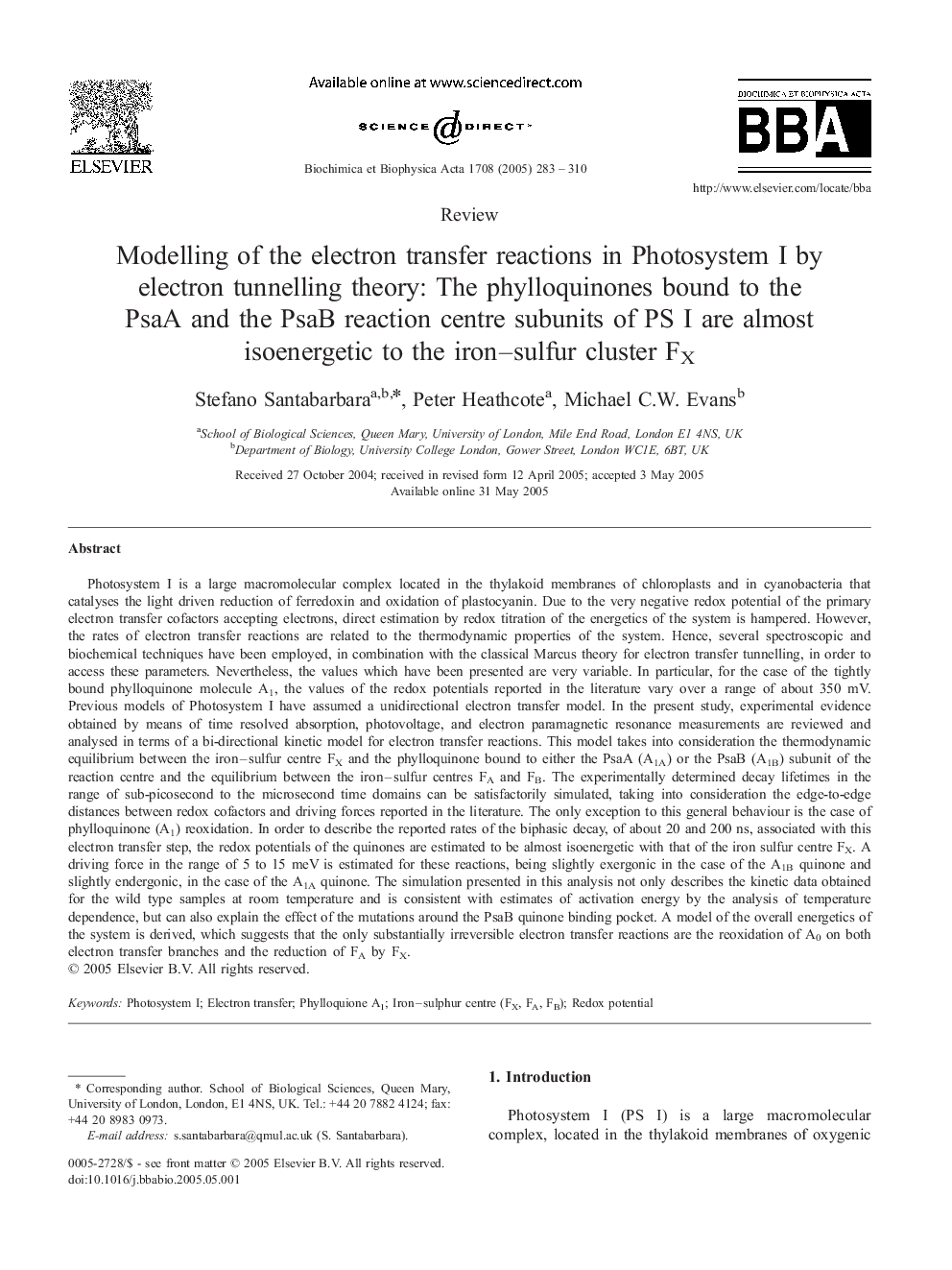| کد مقاله | کد نشریه | سال انتشار | مقاله انگلیسی | نسخه تمام متن |
|---|---|---|---|---|
| 10796088 | 1052692 | 2005 | 28 صفحه PDF | دانلود رایگان |
عنوان انگلیسی مقاله ISI
Modelling of the electron transfer reactions in Photosystem I by electron tunnelling theory: The phylloquinones bound to the PsaA and the PsaB reaction centre subunits of PS I are almost isoenergetic to the iron-sulfur cluster FX
دانلود مقاله + سفارش ترجمه
دانلود مقاله ISI انگلیسی
رایگان برای ایرانیان
کلمات کلیدی
موضوعات مرتبط
علوم زیستی و بیوفناوری
علوم کشاورزی و بیولوژیک
دانش گیاه شناسی
پیش نمایش صفحه اول مقاله

چکیده انگلیسی
Photosystem I is a large macromolecular complex located in the thylakoid membranes of chloroplasts and in cyanobacteria that catalyses the light driven reduction of ferredoxin and oxidation of plastocyanin. Due to the very negative redox potential of the primary electron transfer cofactors accepting electrons, direct estimation by redox titration of the energetics of the system is hampered. However, the rates of electron transfer reactions are related to the thermodynamic properties of the system. Hence, several spectroscopic and biochemical techniques have been employed, in combination with the classical Marcus theory for electron transfer tunnelling, in order to access these parameters. Nevertheless, the values which have been presented are very variable. In particular, for the case of the tightly bound phylloquinone molecule A1, the values of the redox potentials reported in the literature vary over a range of about 350 mV. Previous models of Photosystem I have assumed a unidirectional electron transfer model. In the present study, experimental evidence obtained by means of time resolved absorption, photovoltage, and electron paramagnetic resonance measurements are reviewed and analysed in terms of a bi-directional kinetic model for electron transfer reactions. This model takes into consideration the thermodynamic equilibrium between the iron-sulfur centre FX and the phylloquinone bound to either the PsaA (A1A) or the PsaB (A1B) subunit of the reaction centre and the equilibrium between the iron-sulfur centres FA and FB. The experimentally determined decay lifetimes in the range of sub-picosecond to the microsecond time domains can be satisfactorily simulated, taking into consideration the edge-to-edge distances between redox cofactors and driving forces reported in the literature. The only exception to this general behaviour is the case of phylloquinone (A1) reoxidation. In order to describe the reported rates of the biphasic decay, of about 20 and 200 ns, associated with this electron transfer step, the redox potentials of the quinones are estimated to be almost isoenergetic with that of the iron sulfur centre FX. A driving force in the range of 5 to 15 meV is estimated for these reactions, being slightly exergonic in the case of the A1B quinone and slightly endergonic, in the case of the A1A quinone. The simulation presented in this analysis not only describes the kinetic data obtained for the wild type samples at room temperature and is consistent with estimates of activation energy by the analysis of temperature dependence, but can also explain the effect of the mutations around the PsaB quinone binding pocket. A model of the overall energetics of the system is derived, which suggests that the only substantially irreversible electron transfer reactions are the reoxidation of A0 on both electron transfer branches and the reduction of FA by FX.
ناشر
Database: Elsevier - ScienceDirect (ساینس دایرکت)
Journal: Biochimica et Biophysica Acta (BBA) - Bioenergetics - Volume 1708, Issue 3, 15 July 2005, Pages 283-310
Journal: Biochimica et Biophysica Acta (BBA) - Bioenergetics - Volume 1708, Issue 3, 15 July 2005, Pages 283-310
نویسندگان
Stefano Santabarbara, Peter Heathcote, Michael C.W. Evans,